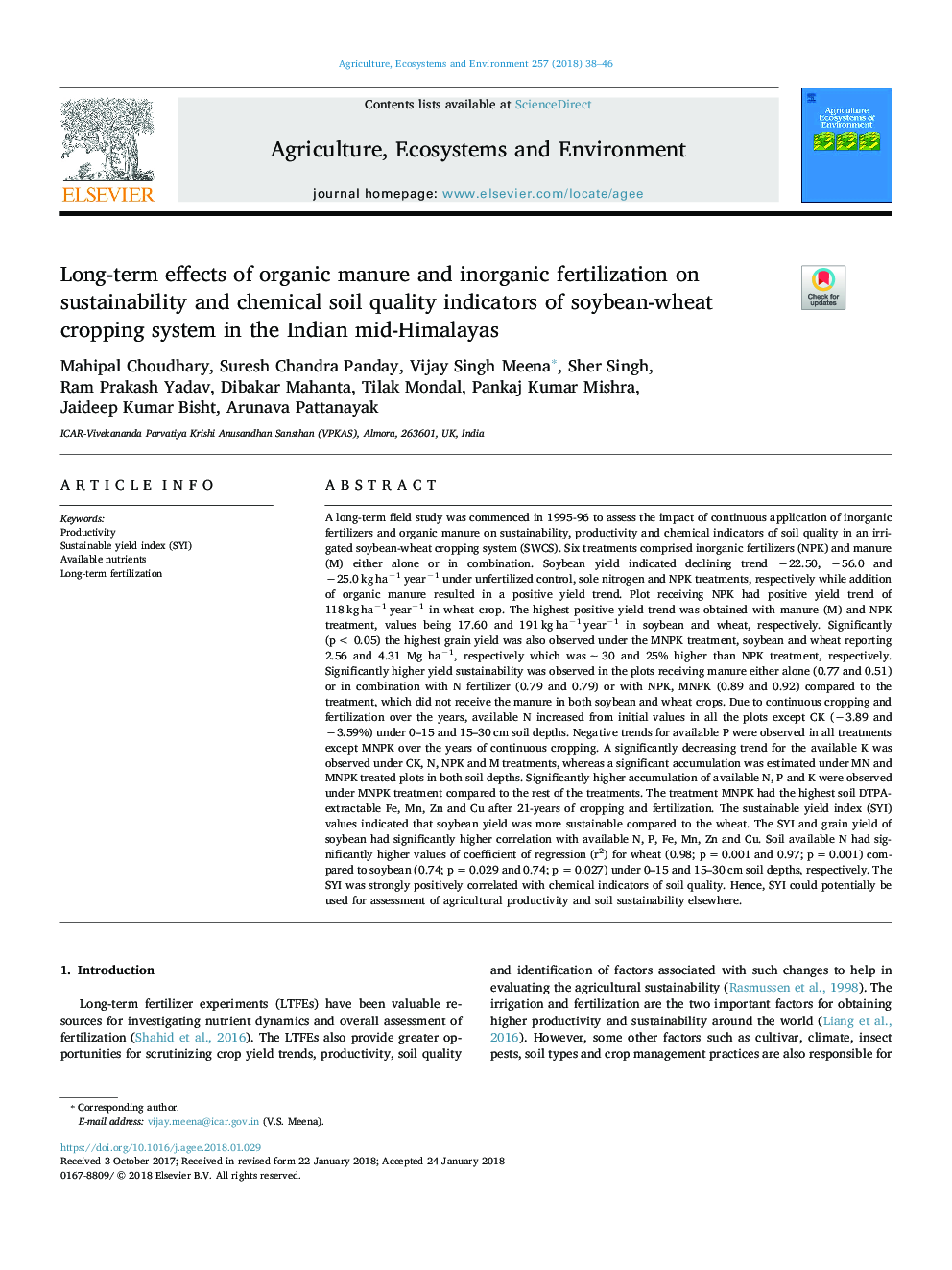| کد مقاله | کد نشریه | سال انتشار | مقاله انگلیسی | نسخه تمام متن |
|---|---|---|---|---|
| 8487136 | 1551995 | 2018 | 9 صفحه PDF | دانلود رایگان |
عنوان انگلیسی مقاله ISI
Long-term effects of organic manure and inorganic fertilization on sustainability and chemical soil quality indicators of soybean-wheat cropping system in the Indian mid-Himalayas
ترجمه فارسی عنوان
اثرات دراز مدت کود آلی و کودهای معدنی بر شاخص های پایداری و شاخص های کیفیت شیمیایی خاک سیستم کاشت سویا-گندم در هند هیمالیا
دانلود مقاله + سفارش ترجمه
دانلود مقاله ISI انگلیسی
رایگان برای ایرانیان
کلمات کلیدی
موضوعات مرتبط
علوم زیستی و بیوفناوری
علوم کشاورزی و بیولوژیک
علوم زراعت و اصلاح نباتات
چکیده انگلیسی
A long-term field study was commenced in 1995-96 to assess the impact of continuous application of inorganic fertilizers and organic manure on sustainability, productivity and chemical indicators of soil quality in an irrigated soybean-wheat cropping system (SWCS). Six treatments comprised inorganic fertilizers (NPK) and manure (M) either alone or in combination. Soybean yield indicated declining trend â22.50, â56.0 and â25.0â¯kgâ¯haâ1â¯yearâ1 under unfertilized control, sole nitrogen and NPK treatments, respectively while addition of organic manure resulted in a positive yield trend. Plot receiving NPK had positive yield trend of 118â¯kgâ¯haâ1â¯yearâ1 in wheat crop. The highest positive yield trend was obtained with manure (M) and NPK treatment, values being 17.60 and 191â¯kgâ¯haâ1â¯yearâ1 in soybean and wheat, respectively. Significantly (p <â¯0.05) the highest grain yield was also observed under the MNPK treatment, soybean and wheat reporting 2.56 and 4.31 Mg haâ1, respectively which wasâ¯â¼â¯30 and 25% higher than NPK treatment, respectively. Significantly higher yield sustainability was observed in the plots receiving manure either alone (0.77 and 0.51) or in combination with N fertilizer (0.79 and 0.79) or with NPK, MNPK (0.89 and 0.92) compared to the treatment, which did not receive the manure in both soybean and wheat crops. Due to continuous cropping and fertilization over the years, available N increased from initial values in all the plots except CK (â3.89 and â3.59%) under 0-15 and 15-30â¯cm soil depths. Negative trends for available P were observed in all treatments except MNPK over the years of continuous cropping. A significantly decreasing trend for the available K was observed under CK, N, NPK and M treatments, whereas a significant accumulation was estimated under MN and MNPK treated plots in both soil depths. Significantly higher accumulation of available N, P and K were observed under MNPK treatment compared to the rest of the treatments. The treatment MNPK had the highest soil DTPA-extractable Fe, Mn, Zn and Cu after 21-years of cropping and fertilization. The sustainable yield index (SYI) values indicated that soybean yield was more sustainable compared to the wheat. The SYI and grain yield of soybean had significantly higher correlation with available N, P, Fe, Mn, Zn and Cu. Soil available N had significantly higher values of coefficient of regression (r2) for wheat (0.98; pâ¯=â¯0.001 and 0.97; pâ¯=â¯0.001) compared to soybean (0.74; pâ¯=â¯0.029 and 0.74; pâ¯=â¯0.027) under 0-15 and 15-30â¯cm soil depths, respectively. The SYI was strongly positively correlated with chemical indicators of soil quality. Hence, SYI could potentially be used for assessment of agricultural productivity and soil sustainability elsewhere.
ناشر
Database: Elsevier - ScienceDirect (ساینس دایرکت)
Journal: Agriculture, Ecosystems & Environment - Volume 257, 1 April 2018, Pages 38-46
Journal: Agriculture, Ecosystems & Environment - Volume 257, 1 April 2018, Pages 38-46
نویسندگان
Mahipal Choudhary, Suresh Chandra Panday, Vijay Singh Meena, Sher Singh, Ram Prakash Yadav, Dibakar Mahanta, Tilak Mondal, Pankaj Kumar Mishra, Jaideep Kumar Bisht, Arunava Pattanayak,
